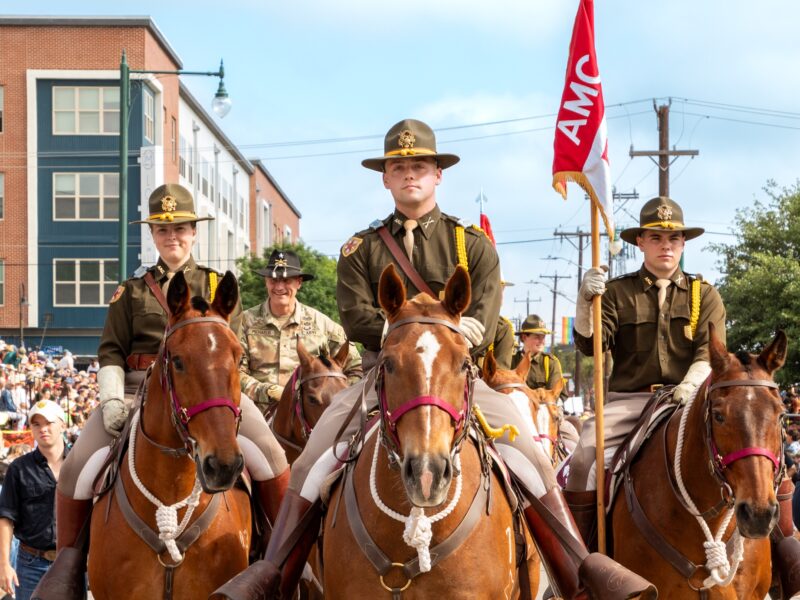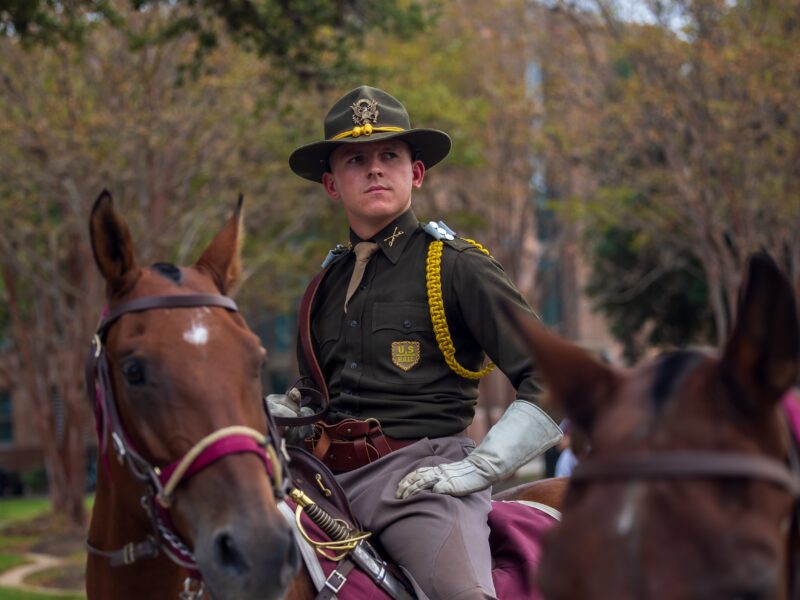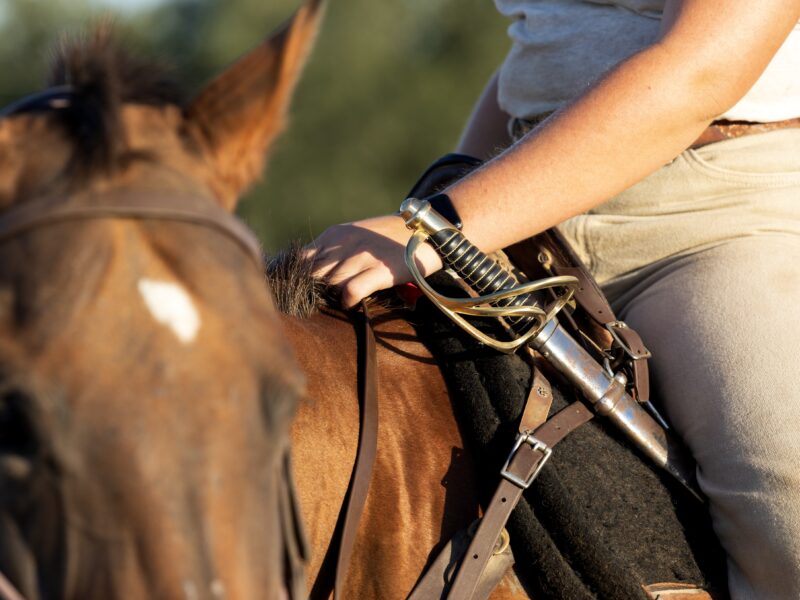Texas A&M Cavalry Horses Help Riders With Disabilities Through Courtney Cares Program
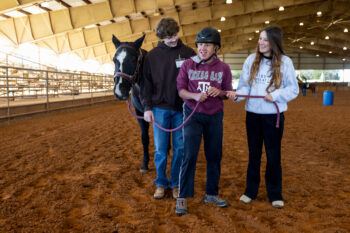
Watching 19-year-old Caleb Autry step into the saddle on a chilly November morning, it’s clear that he and his horse are perfectly in sync.
As they circle around Texas A&M University’s Freeman Arena, a small group of biomedical sciences students walk Autry and his animal partner through a series of exercises meant to test skills like balance, strength and coordination — all under the direction of a professional therapeutic riding instructor.
Autry admits it can sometimes be scary looking down from the top of such a huge animal, but after eight years working on his horsemanship, most of the nerves have vanished.
“It feels like courage to get on a horse,” he said. “They have taught me and brought understanding to me, so that I could equip myself on riding some of these larger animals.”
This semester, Autry and a handful of others with physical and neurological disabilities have been spending time on horseback thanks to a free program at Texas A&M called Courtney Cares. Established in 2012 through a $1.2 million donation from the family of the late Courtney Grimshaw ’85, an accomplished horsewoman and proud Aggie, the program uses the powerful connection between horses and humans to help participants lead more confident and independent lives.
Riders also get a chance to meet and interact with students from Texas A&M’s School of Veterinary Medicine and Biomedical Sciences, who help out with Courtney Cares as part of a class taught by Dr. Priscilla Lightsey and Dr. Nancy Krenek, both physical therapists and certified therapeutic riding instructors.
For Autry, the program has been an opportunity to build new skills and make life-long friends, some of whom have been participating in the program about as long as he has.
“Courtney Cares has been a blessing,” he said. “I’ve learned so much.”
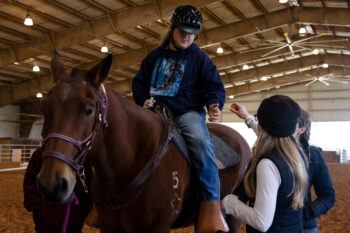
Lightsey said therapies that incorporate horses are unique for a number of reasons, not least of which is that hard-to-define bond between a horse and its rider.
“That is one of the underlying properties that makes this so successful. It’s just a connection that I can’t actually quantify or put in words,” Lightsey said. “An aspect of our program is that after we take them off the horse, we often let them lead the horse. They’re smaller, and the horse is really big, so it gives them what I believe is a sense of empowerment.”
As Lightsey explains, it takes a special kind of horse to want to do this work. Finding an animal with the right training, temperament and movement pattern can be a challenge. Fortunately, the program has a strong stable to pull from — they’ve been trained to ignore sudden movements, stadium-sized crowds and even cannon fire.
Here Comes The Cavalry
Parsons Mounted Cavalry turned 50 years old in 2023, but Bob Byrns ’74 still remembers how it all began. He joined Texas A&M’s Corps of Cadets with a few years of horse experience already under his belt, having learned to ride as a young teenager in West Texas.
“I started when I was in the seventh grade in San Angelo, and I broke and trained horses all through high school,” Byrns recalls. “When I got to A&M, I didn’t have a horse for the first couple of years, but then we started the cavalry and I started working horses here.”
The new unit had been the brainchild of a few senior cadets who got the OK from then-Commandant Col. Thomas R. Parsons ’49 to revive the Corps’ long-dormant tradition of horsemanship.
When the PMC made its debut in 1973, the cadets rode English style — something completely foreign to the young Byrns: “I was from a Western tradition. I had never even seen an English saddle.”
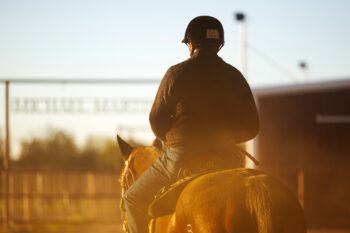
Since then, the unit has grown its contingent of cavalry horses to around 70, making regular appearances at parades and Aggie football games. Byrns returned to Aggieland in 2002 to become the cavalry’s site manager, instructing cadets in the proper care and handling of these important animals.
About a decade into his role with PMC, Byrns said he received an intriguing phone call — a request to borrow a handful of his horses for a new therapeutic riding program on campus.
“They contacted me and said, ‘Do you think cavalry horses could do this?’” he recalls. “I said, ‘I don’t know. I really don’t know, I’ve never done it before. I can train horses to do anything, but I’ve never done therapeutic riding.’”
Still, Byrns had some experience working with special education students during his previous career as a public school teacher, and he said he’d be happy to give it a try. Soon after, the Courtney Grimshaw Equine Therapeutic Program was officially established with support from The Texas A&M University System and expertise from Lightsey and Krenek, Program Director Donelle Beal, and other horse therapy professionals.
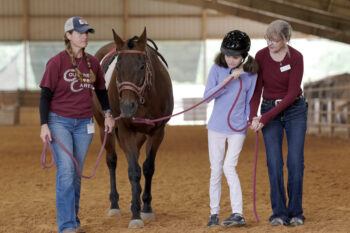
Early on, Byrns discovered that even among a stable of highly-trained horses, only a select few would be suitable for equine therapy.
“We have about 10 or 12 horses that will actually do it,” Byrns said, noting that the ideal horse is calm around humans, willing to take direction, and a bit on the smaller side to accommodate the riders and their instructors.
“We consider it a privilege to be able to work with these horses,” Lightsey said. “It’s a really fun thing because it’s kind of the pride and pulse of Aggieland, and on top of that, we know that they are well taken care of and they have a good environment over there at PMC.”
Down To A Science
Most students who sign up for Lightsey and Krenek’s BIMS 380 class have little-to-no experience with horses, but over the course of the 3-credit hour class they get to see just how beneficial these animals can be to a person’s overall wellbeing.
“I never realized how useful horses are and how much they can help a person,” said biomedical sciences sophomore Avery Carrejo. “Just being with them can be so comforting and help with anxieties or depression.”
For people with injuries or disabilities that impact the ability to walk, spending time on the horse can help simulate the experience of walking, Krenek said, creating a host of positive effects throughout the body.
“In one minute, they get 100 steps,” said Krenek. “If they are in a wheelchair, or they don’t get to walk that much, it’s a radical change for them. It wakes up their body, wakes up their brain, and you get to see all of these different skills develop.”
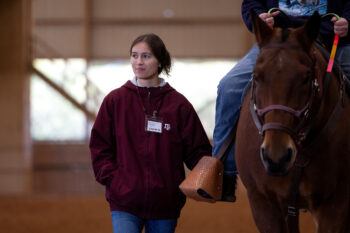
Part of the reason for this change is that a therapy horse’s gait pattern is mechanically similar to that of a human’s, Lightsey said. In 2021, she and Krenek partnered with Texas A&M’s Department of Mechanical Engineering to explore this phenomenon further. The findings of their pilot study were published in the Journal of NeuroEngineering and Rehabilitation.
“We discovered over eight therapy sessions, from the first to the last, the participant began to synchronize with the horse more,” Lightsey said, explaining that this could help improve participants’ mobility when off the horse.
One population that stands to benefit from both the physical and emotional aspects of horse therapy is military veterans, said Byrns, who retired from his post as PMC site manager at the end of 2020 but remains closely involved with Courtney Cares.
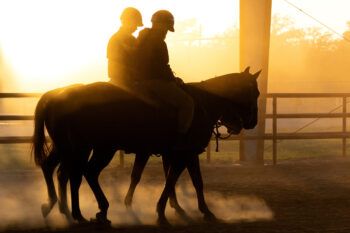
Byrns heads up a separate wing of the program dedicated specifically to serving area veterans, maintaining a small but growing group representing different branches of service and ranging in age from those in their early 20s to 60- and 70-year-olds.
The veterans program is a bit more free-form than the main one, but that’s by design, Byrns said. At the end of the day, whatever a person takes away from the experience is largely between them and the horse.
“We’re much more about just them learning to handle the horse and be around the horse,” he said. “Get whatever intrinsic value you get from a horse, which is different for everybody.”
Media contact: Luke Henkhaus, henkhaus@tamu.edu
